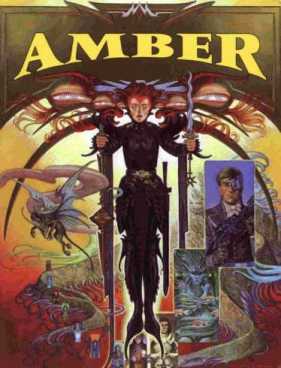
The Amber Diceless Roleplaying Game is a role-playing game created and written by Erick Wujcik, set in the fictional universe created by author Roger Zelazny for his Chronicles of Amber. The game is unusual in that no dice are used in resolving conflicts or player actions; instead a simple diceless system of comparative ability, and narrative description of the action by the players and gamemaster, is used to determine how situations are resolved.
Dragonlance is a shared universe created by Laura and Tracy Hickman, and expanded by Tracy Hickman and Margaret Weis under the direction of TSR, Inc. into a series of fantasy novels. The Hickmans conceived Dragonlance while driving in their car on the way to TSR for a job interview. Tracy Hickman met his future writing partner Margaret Weis at TSR, and they gathered a group of associates to play the Dungeons & Dragons role-playing game. The adventures during that game inspired a series of gaming modules, a series of novels, licensed products such as board games, and lead miniature figures.
Thaumaturgy is the purported capability of a magician to work magic or other paranormal events or a saint to perform miracles. It is sometimes translated into English as wonderworking.

Tracy Raye Hickman is an American fantasy author and designer of games and virtual reality (VR) experiences. He co-authored the original Dragonlance novels with Margaret Weis as well as numerous other books. He also designed and created role playing game material while working for TSR and has cowritten novels with his wife, Laura Hickman. He is the author or co-author of over 60 books.
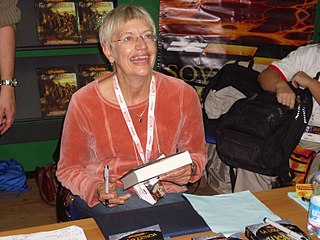
Margaret Edith Weis is an American fantasy and science fiction author of dozens of novels and short stories. At TSR, Inc., she teamed with Tracy Hickman to create the Dragonlance role-playing game (RPG) world. She is founding CEO and owner of Sovereign Press, Inc and Margaret Weis Productions, licensing several popular television and movie franchises to make RPG series in addition to their own.

A campaign setting is usually a fictional world which serves as a setting for a role-playing game or wargame campaign. A campaign is a series of individual adventures, and a campaign setting is the world in which such adventures and campaigns take place. Usually a campaign setting is designed for a specific game or a specific genre of game. There are numerous campaign settings available both in print and online. In addition to published campaign settings available for purchase, many game masters create their own settings, often referred to as "homebrew" settings or worlds.
Jeff Grubb is an author of novels, short stories, and comics, as well as a computer and role-playing game designer in the fantasy genre. Grubb worked on the Dragonlance campaign setting under Tracy Hickman, and the Forgotten Realms setting with Ed Greenwood. His written works include The Finder's Stone Trilogy, the Spelljammer and Jakandor campaign settings, and contributions to Dragonlance and the computer game Guild Wars Nightfall (2006).

Raistlin Majere is a fictional character from the Dragonlance series of books created by Margaret Weis and Tracy Hickman. Raistlin played an extensive role in the two main series of books, particularly in Dragonlance Legends in which he was both primary protagonist and antagonist. He is twin brother to Caramon Majere, half-brother to his protective sister Kitiara uth Matar, and a significant member of the Heroes of the Lance. In the animated movie adaptation, Dragonlance: Dragons of Autumn Twilight, Raistlin was voiced by Kiefer Sutherland.

Lord Soth, the Knight of the Black Rose, is a fictional character appearing in the fantasy realms of Dragonlance and later Ravenloft. He is depicted as a death knight and fallen Knight of Solamnia from the world of Krynn.

Goldmoon is a fictional character from the Dragonlance fantasy series of novels and role playing games, originally published by TSR, Inc. and later by Wizards of the Coast.
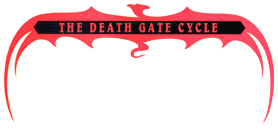
The Death Gate Cycle is a seven-part series (heptalogy) of fantasy novels written by Margaret Weis and Tracy Hickman. The main conflict is between two powerful races, the Sartan and the Patryns, which branched off from humans following a nuclear/anti-matter holocaust. Centuries prior to the events of the series, the Sartan attempted to end the conflict by sundering the Earth into four elemental realms, and imprisoning the Patryns in a fifth prison world, the Labyrinth. The Sartan took up stewardship of the elemental realms, but soon mysteriously lost contact with each other and disappeared. Centuries later, a Patryn known as Xar escaped the Labyrinth, and started returning to the Labyrinth to rescue others. He learned how to access the other worlds, using the eponymous portal called the Death Gate, and dreamed of freeing all his people from the Labyrinth and conquering the other worlds. The books follow the fiercely independent Haplo, a Patryn agent sent to scout the elemental worlds and throw them into chaos in preparation for his Lord's conquest of them. Weis and Hickman created five distinct fantasy worlds during the course of the series, along with developing the cultures of five major races: the unique Patryn and Sartan, and the common fantasy races of dwarves, elves, and humans.
The flexibility of the Dungeons & Dragons (D&D) game rules means that Dungeon Masters (DM) are free to create their own fantasy campaign settings. For those who wanted a pre-packaged setting in which to play, TSR, Wizards of the Coast (WotC), and other publishers have created many settings in which D&D games can be based; of these, the Forgotten Realms, an epic fantasy world, has been one of the most successful and critically acclaimed settings. Many campaign settings include standard sword and sorcery environments, while others borrow Asian, Central American, swashbuckling, horror and even space-travel themes.

Laura Curtis Hickman is an American fantasy author, best known for her works in game design and fantasy novels cowritten with her husband, Tracy Hickman. She was one of the first women to write and publish a tabletop adventure.
The DL series is a series of adventures and some supplementary material for the Advanced Dungeons & Dragons role playing game. These modules along with the Dragonlance Chronicles trilogy of novels, which follow one possible adventure series through the modules, were the first published items that established the Dragonlance fictional universe. The original DL series was released from 1984 to 1986, with the final two modules added to it in 1988. In the 1990s these roleplaying adventures from the original series were collected and revised for 2nd Edition AD&D as the three DLC Dragonlance Classics modules. There were also versions of the module series released in 1999, 2000 and 2006.
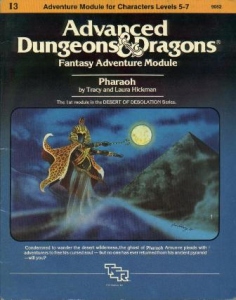
Desert of Desolation is a compilation adventure module published by TSR for the Dungeons & Dragons (D&D) fantasy roleplaying game. It combines three previously published individual modules: Pharaoh, Oasis of the White Palm, and Lost Tomb of Martek. The modules were made for use with the first edition Advanced Dungeons & Dragons (AD&D) rules. Pharaoh was created by Tracy and Laura Hickman soon after the couple married in 1977, and published by TSR in 1982. Oasis of the White Palm was a collaboration between Tracy Hickman and Philip Meyers, and Hickman wrote the Lost Tomb of Martek on his own; both were printed in 1983.

The Dresden Files Roleplaying Game is a licensed role-playing game based on The Dresden Files and using the Fate system. It was released in late 2010 in two hardcover volumes: Your Story with the rules information and Our World with setting information, and won numerous awards at all of the Origins Awards, the ENnies, and the Golden Geek Awards.
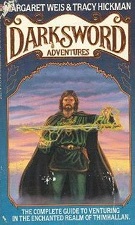
Darksword Adventures is a book by Margaret Weis and Tracy Hickman that was published by Bantam/Spectra in 1988. It describes the world of Thimhallen, the setting the Darksword trilogy written by Weis and Hickman. Most of the book describes the world and its history. The final chapter, "Phantasia", describes a fantasy role-playing game that is set in Thimhallen.
This is complete list of works by American science fiction and fantasy novelist Tracy Hickman.
The Cortex System is a collection of related roleplaying games. Its most recent iteration, Cortex Prime, was designed by Cam Banks and published by Fandom Tabletop. Prior versions appeared in the licensed roleplaying games published by Margaret Weis Productions, where it was used as the house system. Cortex is an adaptable game system focusing on characterization and story development.











